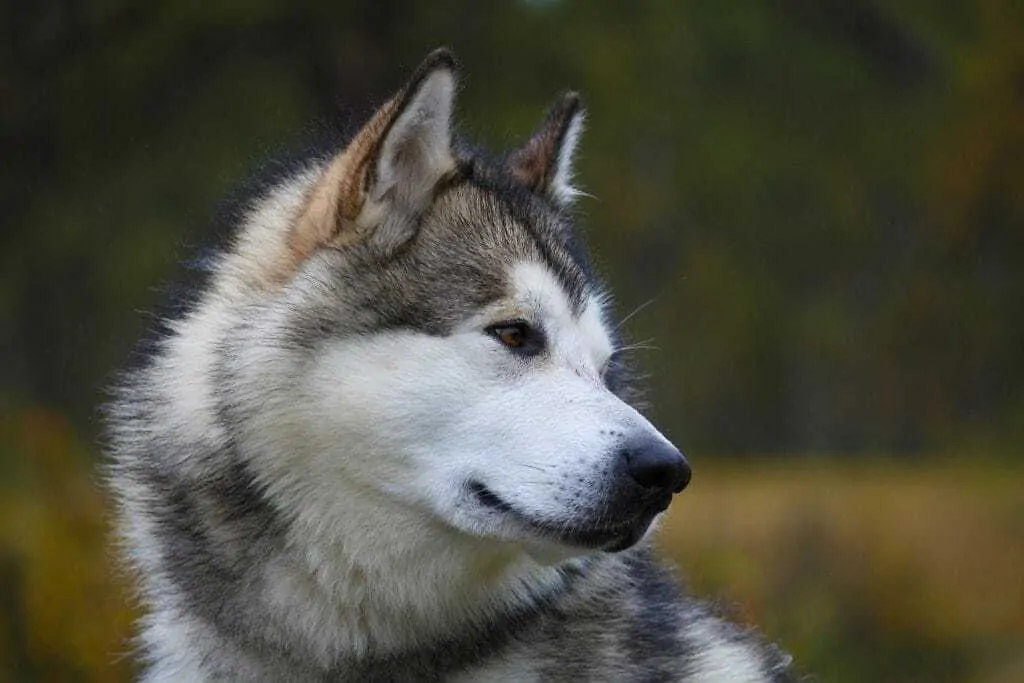Want to know more about the Alaskan Malamute? We’ll be going over 11 different facts on the breed below.
Despite their visual similarities, Mals are much bigger than Siberian Huskies. Here is our full Alaskan Malamute vs Siberian Husky comparison.
Weighing in at nearly 100 pounds, Alaskan Malamutes are anything but small. One of the oldest breeds of Arctic sled dogs, they are perfectly capable of pulling heavy loads for miles and miles in the snow. Not only do they turn heads with their incredible size, but their thick fur coats are just as striking. Affectionate and friendly, they tend to get along with humans and other animals. For one thing, they’ll never turn down an invitation to play—even if the other party is much smaller than themselves!
As with most breeds of dog, they bring their own unique set of traits to the table. While there’s no doubt that they’re cute, they can be a lot of work. Surely, their history as sled dogs alone says something about their exercise requirements? If you’re considering on bringing a Mal home, be sure to do your research! Nothing is as worse as being completely under-prepared as a new dog owner.
Contents
The Alaskan Malamute is a Primitive Breed
Genetically, Mals are one of the breeds that is the most similar to the wolf. Some other primitive dog breeds include the Siberian Husky, Akita, Chow Chow, Saluki, Samoyed, and Basenji, to name a few.
An ancient dog breed, Mals fall into a category called “Primitive Dogs.” Ultimately, what this means is that they are genetically similar to their ancestral wolves. Despite the passing of many millennia, they have managed to retain many primitive traits and behaviors. As a result, they are much more independent—especially when compared to some of the “newer” breeds like the golden retriever. As a result, they can be fairly difficult to train.
The Alaskan Malamute is Prey Driven
Mals have an incredibly high prey drive. Factor in their enormous size and strength, and it’s easy to see their huge hunting potential. Not only will they chase, but they’ll chase for the kill. If they see a small critter, chances are, they’ll be after it before you know it. In fact, they are infamously known for injuring and killing other pets such as rabbits, birds, rats—even cats. Seeing as how they used to help the indigenous people hunt seals and polar bears, however, this really isn’t all too surprising. The Mal is a great search and rescue dog for this reason.
The Alaskan Malamute is Friendly
Mals tend to be friendly and affectionate—a trait that they share with Huskies.
The breed is generally friendly. Despite their large size, they are eager to greet everyone they meet. Playful and goofy, they will gladly take all the attention that they can get—whether it’s from their human or a stranger that they’ve only known for about two minutes. Affectionate to a fault, there’s no doubt that they form unbreakable bonds with their owners.
The Alaskan Malamute has a Lot of Energy
As expected from a working breed, they are very high in energy. Unless you have an older dog, you’ll have to be ready to dedicate a good chunk of time and energy towards their exercise needs (generally two to three hours a day). Because of this, they are generally not suited for apartment life; they would do much better with a large, fenced-in yard. If they’re ever bored—you’ll be the first know about it. Furniture, carpet—you name it, they’ll be off to destroy something.
The Alaskan Malamute is Prone to Same-Sex Aggression
Same-sex aggression can be a problem with some Mals.
Despite the fact that they are generally friendly, Mals tend to be prone to same-sex aggression. A dominance issue, things can quickly escalate into a serious fight between two males or two females. As with most things, however, it does depend on the individual dog; for some, it won’t be an issue at all. Considering the risks, however, caution should be exercised when introducing one to a dog of the same sex.
The Alaskan Malamute Should Not be Trusted Off Leash
The dog should not be trusted off leash; the risk of them running away is simply too high given their spectacular prey drive. The second they see a small animal will be the second that they decide to chase after it—even if it means running straight into a busy street. Given the right motivation, they’ll even jump out of a fenced-in backyard (they do have powerful legs after all). Vigilance is key.
The Alaskan Malamute Can be Chatty
Mals are known for their distinctive howls and “woo woo” sounds.
Malamutes rarely bark, for the most parts, anyway. Instead, they like to express themselves with cute “woo woos” or howling. A chatty breed, they very much enjoy holding conversations with their people. If there’s something on their mind, they’ll be sure to tell you about it. There’s just one thing—their howls can easily be as loud and big as their personality!
The Alaskan Malamute are Independent Thinkers
Highly intelligent, they have no problems comprehending commands; listening and obeying, however, is an whole different question. Harder to train than the average dog, they’ll constantly be asking the question—“why?”. One of the traits that come from being a primitive breed, their independent personality often leads them to do things on their own terms.
Alaskan Malamutes are Fur Factories
The Malamute sheds a lot due to the fact that they have a thick, double-coated coat.
With how big they are, shedding is a given. If you want the amount of hair to be somewhat manageable, you’ll probably have to do a bit of regular brushing. Even then, it’s probably worth it to invest in a high-quality vacuum cleaner. Also, don’t forget that they blow their coats twice a year—during which your house will be completely covered in fur.
The Alaskan Malamute Can Easily be Overfed
Despite having very efficient metabolisms, Mals will never say no to food. Given the chance to eat as much as they can, they will devour everything. Unfortunately, this means that they can easily be overfed, which leads to obesity. A serious health condition, it can cause an array of issues from diabetes to joint pain. A simple and easy way to prevent this is to portion their meals every day.
The Alaskan Malamute is Different From the Husky
Mals may look like Huskies at first glance, but they have entirely different origins (not to mention the obvious size difference).
To the untrained eye, the Mal may look like a Husky, and vice versa. When you examine the two dog breeds more closely, however, there are a few distinct differences—the most obvious being size. While both have a sled dog history of pulling sleds, Malamutes are able to carry much more weight due to their strong build; in contrast, Huskies were bred to pull less, but at a much quicker speed. Depending on who you ask, some may even tell you that Mals are more laid back than their Husky counterparts! The Mal is a great long-haul sled dog.
Alaskan Malamute Breed Information
Other Names
Mal, Mally
Color Variations
Black and white, grey and white, red and white, and solid white
Origin
One of the oldest sled dogs in the world, Mals were originally companion dogs to the Mahlemut tribe. Although their origin is not clearly known, many consider them to be descendants of the Mahlemut dog. In addition to pulling heavy loads, they also played helped with hunting seals and polar bears in the Arctic.
Dog Breed Group
Working Group
Height
Females: Approximately 23 inches at the shoulders
Males: Approximately 25 inches at the shoulders
Weight
Females: Around 85 pounds
Females: Around 75 pounds
Life Span
10 to 14 years
Breed Characteristics
Temperament
They are affectionate and friendly. While loyal, they enjoy the presence of all humans—for this reason, they are hardly a “one man” dog.
Adaptability
They are highly adaptable. While they thrive in cooler areas, they can tolerate warmer climates if given proper shelter and water.
Barking Tendencies
In addition to barking, they have a tendency to howl.
Apartment Friendly
Due to their size and exercise requirements, they tend to do better in a house setting.
Cat Friendly
They are generally not cat friendly due to their high prey drive.
Child Friendly
They are child friendly.
Intelligence
High
Playfulness
Very high
Dog Care
Nutrition
They are known for eating less than other dogs their size. Nonetheless, they require a healthy diet to support their nutritional needs.
Grooming
Mals do not require frequent grooming; however, occasional brushing is recommended to prevent hair mats. Baths can be given once every few months, or on an as-needed basis.
Shedding Level
High
Exercise Level
Very High
Training/Trainability
A primitive breed, Mals can be difficult to train. While intelligent, they can be stubborn; persistence is key when training the breed.
Known Health Issues
As with most large dogs, the dog is prone to hip dysplasia. In addition to that, they are susceptible to cataracts, progressive retinal atrophy, and inherited polyneuropathy. Stomach twisting or bloating is also common.
The Malamute is recognized by the American Kennel Club, Malamute Club of America and Alaskan Malamute Club.

Jen Jones is a professional dog trainer and behavior specialist with more than 25 years of experience. As the founder of ‘Your Dog Advisor’ and the ‘Canine Connection’ rehabilitation center, she applies a holistic, empathetic approach, aiming to address root causes rather than merely treating symptoms.
Well known for her intuitive and compassionate approach, Jen adopts scientifically-proven, reward-based methods, encouraging positive reinforcement over punishment. Jen specializes in obedience training, behavior modification, and puppy socialization. Her innovative methods, particularly in addressing anxiety and aggression issues, have been widely recognized. Jen has worked with many of the world’s leading dog behaviorists and in her free time volunteers with local animal shelters and rescue groups.






